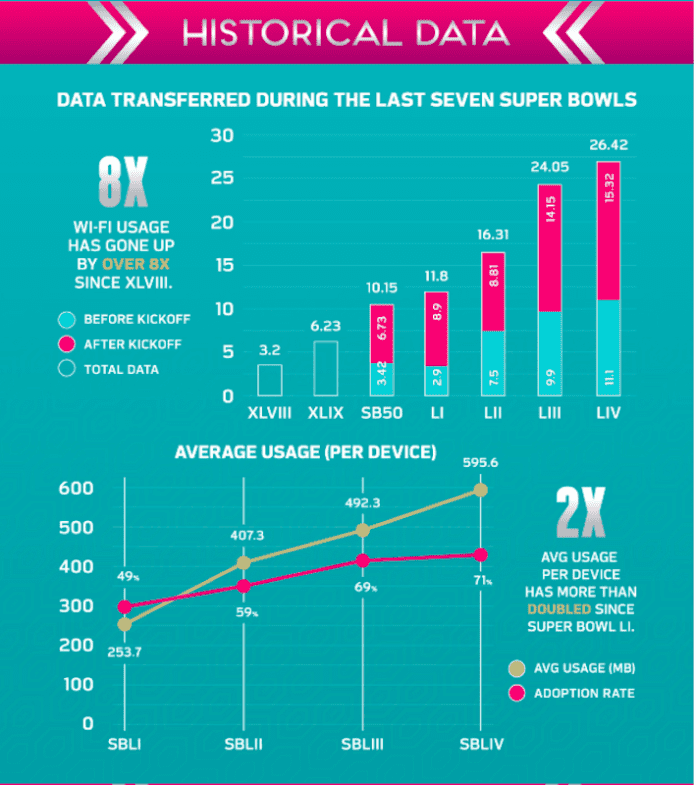While the Kansas City Chiefs—from Missouri, by the way—and the San Francisco 49ers went head-to-head at the Hard Rock Stadium in Miami, another impressive show of strength and endurance was taking place. To be clear, I’m talking about signal strength, both cellular and Wi-Fi.
This is the seventh consecutive year the National Football League has used Extreme Networks’ Wi-Fi analytics and solutions, and at this year’s Super Bowl, the company worked with Verizon, who provided its commercial 5G Ultra Wideband network, which runs on mmWave spectrum, to fans with compatible phones.
The idea, John Brams, director of sports and entertainment at Extreme Networks, told RCR Wireless News, was to provide the best fan experience as possible and to create a seamless transition for fans as they moved back and forth from cellular and Wi-Fi coverage.
“Verizon, of course, invested in 5G and 4G implementation around the stadium, and then there is also the Wi-Fi network, which in addition to providing more bandwidth for users, also extended Verizon’s capacity onto Wi-Fi. So if you’re a Verizon user, you automatically and seamless authenticate,” he explained.
For its part, Extreme Networks installed roughly 2,000 access points and antennas hidden throughout the stadium, sometimes under fans’ seat. As a result, the stadium was fully covered—as well as some areas outside the stadium, so that things like ticket scanning could be performed on the network, according to Brams.
“That’s a lot of infrastructure, but we had 62,000 fans to cover,” he added.
And how much data can 62,000 fans use, you might ask? Turns out, a whole lot.
“We broke another record,” said Brams. “Inside the stadium, we did over 26 terabytes of data during the game period, which is the most data ever transferred at any public venue for any event.”
To better illustrate that inconceivable amount of data, Brams explained that 26 terabytes of data is equivalent to over 1,500 reams of paper with typing on both sides.
“If you were to then to stack all those papers, you would have a pile as high as the Eiffel Tower,” he elaborated.
As a refresher, the Eiffel Tower stands at 300m tall, and paper is very thin.

According to Bram, an analysis of data usage during the game revealed an interesting trend in the way that the network is being used by fans.
“If you look over the last three or four Super Bowls, there is tremendous amount of data being used before the game,” he continued, adding that people are arriving to the stadium earlier because the NFL is making an effort to lengthen the game day experience by putting more activities in and around the stadium.
“This year, there was almost 11 terabytes of data before the game and 15 after, compared to last year, which saw nine before and 14 after,” he stated.
Extreme Networks expects this trend to continue.

Brams felt it was important to point out that while 26 terabytes of data is absolutely impressive, it is a hard to compare the network health of large public venues because there are a lot of variables to consider, like weather and size.
“A better way to look at the health of a network is to look at how much data the average user transmits,” he offered.
At this year’s Super Bowl, the average fan transferred around 600 megabytes, compared to the 492 reported last year, a more than 100-megabyte increase.
All of this, said Brams, is exciting and proves that age-old adage: if you build it, they will come.
12 NFL teams leverage Extreme Networks’ Wi-Fi, while 25 make use of the company’s analytics, and Verizon provides its 5G/4G coverage to 13 NFL stadiums.

